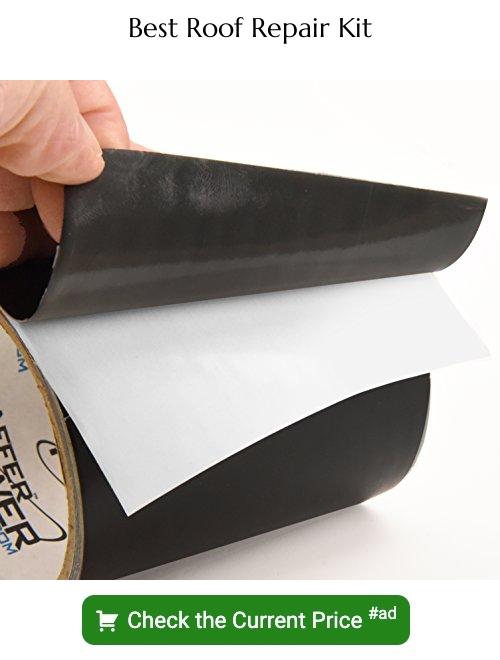Last updated on
When disaster strikes because your shingles blew off your roof, this comprehensive guide will arm you with the knowledge you need to address the damage and fortify your home against future gusts.
Key takeaways:
- Shingles can be blown off due to design, installation, and weather-related factors.
- High winds and storms can cause shingle damage and displacement.
- Improper shingle installation increases the risk of blow-off.
- Promptly replacing blown-off shingles is essential to prevent water damage.
- Missing shingles compromise the roof’s overall integrity and ventilation.
Reasons That a Roof Shingle May Be Blown Off

A shingle’s first line of defense against the elements is its design and installation. When these are compromised, the likelihood of displacement increases substantially. High winds are notorious for prying loose shingles that haven’t been properly nailed down or that have adhesive failures. Storms, particularly those with strong gusts, can create a lifting effect on the edges of shingles, effectively peeling them from the roof.
Underlying weaknesses in the roofing material, such as cracks or blisters, also contribute to shingle loss during severe weather. Over time, exposure to the sun’s ultraviolet rays and fluctuating temperatures can cause shingles to become brittle and more susceptible to wind uplift. Moreover, inadequate ventilation in the attic can lead to moisture buildup, weakening the roof’s structure and the shingle’s attachment.
Improper shingle installation is another critical factor. Shingles must overlap correctly and be fastened with the right number of nails in specific positions to resist wind lift. Deviations from these best practices can leave shingles vulnerable to being caught by the wind. Missing or damaged flashing, that should protect and seal different parts of the roof, may also enable strong winds to grab hold of shingles and strip them from the roof.
To ensure optimal performance, it’s essential to use quality materials, ensure proper installation, and conduct regular maintenance. These steps help guard against the common issues that lead to shingles being blown off, thereby extending the lifespan of the roof.
High Winds and Storm Conditions

Shingle loss frequently occurs during bouts of tempestuous weather. Wind speeds as low as 50 miles per hour can create enough force to lift and displace shingles. The risk intensifies with the “wind uplift” effect, where air flows under the shingle edge, magnifying the lifting force.
Storms can also contribute to the damage by hurling debris that compromises shingle integrity, making them more susceptible to wind displacement. Additionally, pre-existing weaknesses such as loose or cracked shingles from normal wear and tear are more likely to be dislodged during severe weather.
Regularly check for and repair these vulnerabilities to bolster your roof’s defense against the next high wind event.
Improper Shingle Installation
A shingle that hasn’t been secured correctly can become a weak point susceptible to wind uplift. Here are a few indicators of poor installation:
- Nailing errors: Shingles should be fastened with the right number of nails, typically four to six, depending on the wind zone. Nails should be driven straight and not at an angle, and must penetrate through the shingle into the roofing deck.
- Misplaced nails: Correct placement secures the top of the shingle below. Nails should not be too high or too close to the edges, as this can lead to slippage or prevent the shingle tabs from sealing properly.
- Inadequate sealing: Shingles feature a self-sealing strip that bonds them together. If shingles are not properly aligned or if debris hinders the seal, they may not stick together, increasing the chance of wind damage.
- Inconsistent shingle overhang: There should be a slight overhang at the roof’s edge, usually between 1/4 and 3/4 inches, to ensure proper water runoff. Too much overhang, and shingles can catch wind; too little, and water may infiltrate the roof deck.
- Ignoring manufacturer instructions: Manufacturers provide specific guidelines for shingle installation, including temperature conditions and handling. Deviations from these instructions can compromise the shingle’s performance and longevity.
Understanding these points helps to identify potential flaws in shingle installation, which can be addressed to enhance the roof’s resilience against wind uplift and prevent future shingle blow-off.
Steps to Replacing a Blown Off Roof Shingle
Ensure safety first by using a sturdy ladder and wearing non-slip shoes to prevent falls. If the roof is steep or if you’re uncomfortable at heights, consider hiring a professional.
Clear away any remaining portions of the damaged shingle and debris from the affected area to prepare for the new shingle.
Slide a flat pry bar under the shingle directly above the empty space to lift the bottom edge, freeing the sealing strips.
Carefully remove the nails from the shingle above with the pry bar, ensuring you don’t damage it.
Fit the new shingle into the space, aligning it with those on either side. Nail the shingle into place with roofing nails, typically four per shingle, and hammer the nails from the shingle above back down to resecure it.
Seal the edges of the new shingle with roofing cement to ensure a tight bond and prevent wind from catching it in the future.
Safety Considerations and Precautions
Before starting any repair work, prioritize safety by wearing appropriate gear such as slip-resistant shoes, gloves, and eye protection.
Ensure that the ladder is stable and conforms to safety standards, and never work on the roof during wet or windy conditions.
It’s also crucial to have a helper on the ground for assistance and to follow all manufacturer’s instructions when using roofing tools and materials.
Additionally, considering a safety harness may be wise, especially if the roof’s slope is steep or the house is more than one story tall.
Always be aware of your surroundings, especially power lines or tree branches that may pose risks.
Removing Damaged Shingle Remnants
Begin by carefully lifting the edges of the surrounding shingles to free the damaged piece. Use a flat pry bar to gently remove the nails securing the shingle. If the nails are difficult to extract and the shingle slides out, the nails can remain in place to be used for the new shingle.
Clear away any leftover debris to prepare a clean surface for the new shingle. It’s important to proceed with caution to avoid damaging the intact shingles or the roof decking.
Installing the New Shingle
Begin by placing the new shingle into position, ensuring it aligns with those on either side for a uniform appearance. Slide the shingle into the gap left by the old one, under the shingle directly above it. This overlap is crucial for waterproofing.
Nail the shingle securely in place, driving at least four nails in the designated nailing strip. The nails should be positioned so the row above covers them, which helps prevent water seepage.
Seal under the edges of the installed shingle by applying a small amount of roofing cement. This extra step reinforces the attachment and improves resistance to future wind uplift.
Finally, press down firmly to set the shingle in place. Proper adherence to the roof is key to prevent it from being lifted by wind once again.
How Quickly You Should Replace Blown Off Shingles
Time is of the essence when dealing with missing shingles. Left unaddressed, even a single day of rain can seep through the exposed area, leading to water damage within the home. This moisture can compromise not only the roof decking but also the insulation, electrical systems, and interior ceilings. It’s crucial to act promptly to prevent mold growth, which can begin within 48 hours of moisture exposure.
Moreover, an incomplete shingle layout compromises the roof’s integrity. When shingles are missing, neighboring shingles are more prone to damage due to increased vulnerability to wind lift. Hence, it’s advisable to inspect the roof after every significant weather event and replace missing shingles as soon as possible to maintain the roof’s overall protective function.
Risk of Water Damage
Exposed roof decking or underlayment due to missing shingles may lead to water infiltration. This can result in:
- Ceiling Stains: Water seeping through can discolor interior ceilings, indicating moisture accumulation.
- Mold Growth: Damp conditions are ideal for mold, which can compromise indoor air quality and cause health concerns.
- Attic Damage: Wooden structures in the attic may rot if water access is unchecked, jeopardizing structural integrity.
- Insulation Deterioration: Wet insulation loses its thermal resistance, leading to higher energy costs and reduced comfort.
- Electrical Hazards: Water leaks near electrical fixtures raise risks of short circuits or electrical fires.
Timely shingle replacement is crucial to mitigate these risks and maintain the roof’s function as a home’s primary weather defense.
Impact On Roof’s Overall Integrity
A compromised shingle can expose the underlayment of a roof to the elements, leading to leaks that may not be immediately apparent from inside the home. Over time, water infiltration can cause rot in the decking and create a fertile environment for mold and mildew to grow, which deteriorates the roof structure and diminishes its ability to protect the home.
Subsequent wind events are more likely to cause additional damage, as the surrounding shingles, now facing increased exposure and weakened themselves, become more susceptible to being torn off. This creates a cascade effect that potentially compromises larger areas of the roof.
Moreover, the loss of even a single shingle impacts the roof’s ventilation and thermal regulation. An intact roof operates as a system that regulates attic temperatures and air flow, so damage disrupts this balance, which could lead to increased energy bills and decreased comfort levels in extreme temperatures.
Therefore, timely repairs are crucial not just for the missing shingle, but also to maintain the overall integrity and functionality of the roofing system.
FAQ
What to do when roof shingles fall off?
Replace shingles lost to wind, minimize walking on them if they break due to foot traffic, consider asking your roofer for a proper installation if faulty workmanship is the issue, or replace them entirely if they are simply too old.
Is it normal for shingles to come off roof?
Yes, it is normal for shingles to come off the roof during heavy weather conditions such as rain, wind, or hail storms, or due to falling trees and blowing debris.
Will my roof leak if a shingle is missing?
Yes, your roof can potentially leak if a shingle is missing as this exposes an unprotected gap for water to seep in during rainfall, causing a leak.
Can you reuse shingles that blew off?
No, shingles that blew off should not be reused as they are typically damaged, and reusing them goes against building code.
How can one avoid potential shingle blow-off during high winds?
To prevent shingle blow-off during high winds, homeowners should hire a professional roofer to ensure their shingles are properly installed, nailed down securely, and the roof is maintained regularly.
What are the potential consequences of not replacing missing shingles promptly?
Not replacing missing shingles promptly can lead to roof leaks, water damage, higher energy bills, and decreased home value.
Should a professional roofer be hired to replace blown-off shingles, or can it be a DIY task?
While it is possible for a technically-inclined homeowner to replace blown-off shingles, hiring a professional roofer is typically recommended to ensure proper installation and prevent further damage.





